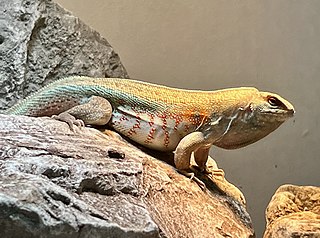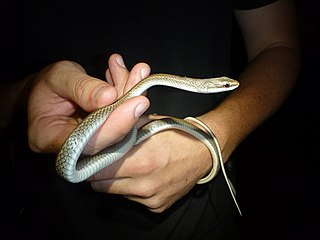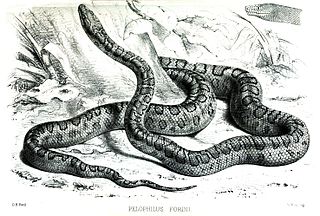
Leiocephalidae, also known as the curlytail lizards or curly-tailed lizards, is a family of iguanian lizards restricted to the West Indies. One of the defining features of these lizards is that their tail often curls over. They were previously regarded as members of the subfamily Leiocephalinae within the family Tropiduridae. There are presently 30 known species, all in the genus Leiocephalus.
Cochran's croaking gecko, also commonly known as Cochran's Caribbean gecko and the Navassa gecko, is a species of lizard in the family Sphaerodactylidae. The species was described in 1931 by Chapman Grant and named after notable American herpetologist and artist Doris Mable Cochran. The species received one of its common names from the loud croaking call of the male during the mating period.

The Martinique curlytail lizard is an extinct species of lizard in the family of curly-tailed lizard (Leiocephalidae).
Cyclura cornuta onchiopsis, the Navassa Island iguana, was a subspecies of rhinoceros iguana that was found on the Caribbean island of Navassa.

Leiocephalus carinatus, commonly known as the northern curly-tailed lizard or saw-scaled curlytail, is a species of lizard in the family Leiocephalidae.
Leiocephalus loxogrammus, commonly known as the Rum Cay curlytail lizard and the San Salvador curlytail, is a lizard species in the family of curly-tailed lizard (Leiocephalidae). The species is endemic to The Bahamas and is only known to be found on San Salvador Island and Rum Cay.
Leiocephalus greenwayi, commonly known as the East Plana curlytail and the Plana Cay curlytail lizard, is a species of lizard in the family of curly-tailed lizards (Leiocephalidae). The species is native to the West Indies.
Leiocephalus inaguae, commonly known as the Inagua curlytail lizard, is a species of lizard in the family Leiocephalidae.

The Hispaniolan curlytail lizard, also known as the Hispaniolan khaki curlytail, the red-sided curlytail lizard, the red-sided curly-tailed lizard, or Schreibers's curly-tailed lizard, is a common lizard species in the family Leiocephalidae. It is native to Hispaniola in the Caribbean, and an introduced population is found in southern Florida. There are two recognized subspecies.

Gymnophthalmus pleii, known commonly as the Martinique spectacled tegu and the rough-scaled worm lizard, is a species of lizard in the family Gymnophthalmidae, a family known commonly as "microteiids". The species is found in the Caribbean, on the Lesser Antilles islands of Guadeloupe, Dominica, Martinique, Saint Lucia, and Maria I.

Barbour's tropical racer is a species of snake in the family Colubridae. The species is endemic to the Caribbean.

The island least gecko is a species of gecko endemic to the Lesser Antilles in the Caribbean.

Chilabothrus fordii, also known commonly as Ford's boa and the Haitian ground boa, is a species of snake in the family Boidae. There are three recognized subspecies.
Typhlops capitulatus, commonly known as the Haitian pale-lipped blind snake or Richmond's worm snake, is a species of snake in the family Typhlopidae. The species is endemic to Haiti. There are no subspecies that are recognized as being valid.

Aristelliger praesignis, is a species of gecko, a lizard in the family Sphaerodactylidae. The species is endemic to Jamaica and the Cayman Islands.
Beck's least gecko is a species of lizard in the family Sphaerodactylidae. The species is endemic to Navassa Island.
Ramsden's least gecko is a species of lizard in the family Sphaerodactylidae. The species is endemic to Cuba.

Leiocephalus sixtoi, also known as the Hispaniolan dune curlytail, the dune curly-tailed lizard, or Sixto'scurly-tailed lizard is a species of lizard in the family Leiocephalidae. This species is endemic to the island of Hispaniola, and is only known in the sandy spaces of monumento natural Las Dunas de las Calderas, also known as Las Dunas de Baní.

Diploglossus delasagra, also known as the Cuban galliwasp, the Cuban pale-necked galliwasp, or la culebrita de cuatro patas, is a species of lizard in the family Diploglossidae endemic to Cuba.











